Making your own all-natural herbal salve is so easy! This salve is the perfect beginner recipe for a novice herbalist. It has powerful, soothing benefits thanks to all the herbs it contains, and smells divine! Learn how to make an herbal salve using herbs and plants you can find in your own backyard or grow in your garden.
Homemade Herbal Salve Recipe
I’m so excited about this post, as it is something I’ve been wanting to do for a long while! If I had known how easy this is, I would have done it years ago.
I’m going to show you how to make an herbal salve using herbs you can forage or that are most likely growing in your garden.
The best part about it is that you can use any number of herbs. It doesn’t have to be the exact ones I show you here, as there are many with powerful, soothing properties.
Choosing and Drying Herbs for Herbal Salve
Alrighty, let’s get into the details of this salve-making!
The first step in the process is to make an herbal oil infusion, which sounds a lot more complicated than it actually is. There are a few different ways to do this, but the first thing you need are herbs.
For this salve, I used plantain leaves, comfrey leaves, yarrow leaves and flowers, lavender flowers, and lemon balm leaves.
There are many other medicinal plants and herbs that can be used, such as calendula, St. John’s wort, dandelion, and arnica.
I foraged the herbs for this salve, but you can also purchase high-quality, organic dried herbs from Mountain Rose Herbs.
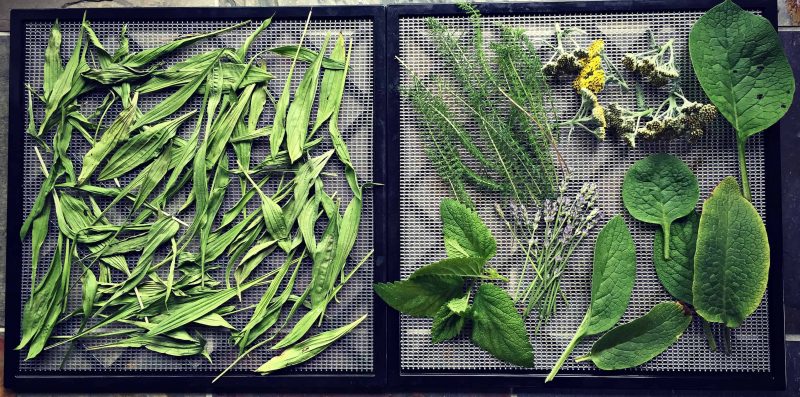
Want to save this post for later?
If you are using freshly foraged or homegrown herbs, you will need to dry them first.
Hang them upside down for several weeks, use a drying screen, or, if you need them in a hurry and you happen to have a food dehydrator (Excalibur is best), use that as well.
Since I was making yogurt in my dehydrator already, I decided to do double duty and dry my herbs at the same time.
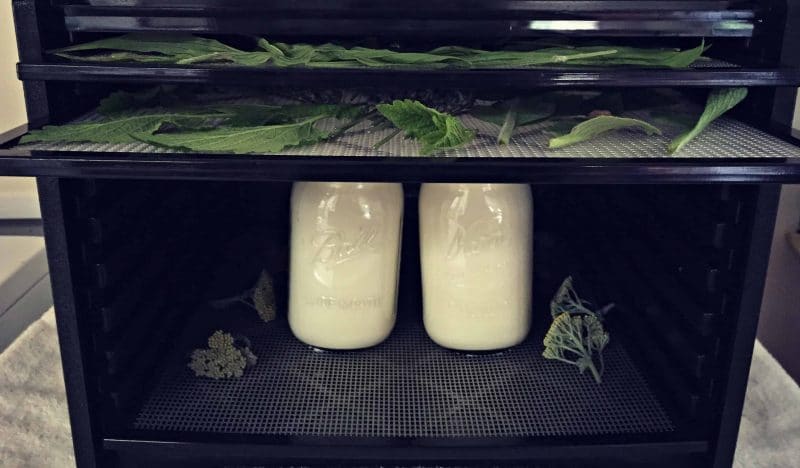
In general, it’s important to make sure that your herbs are completely dry before you make your oil infusion, or else mold can form, and it will go rancid.
There are a few herbs that are better infused fresh however, such as St. John’s wort.
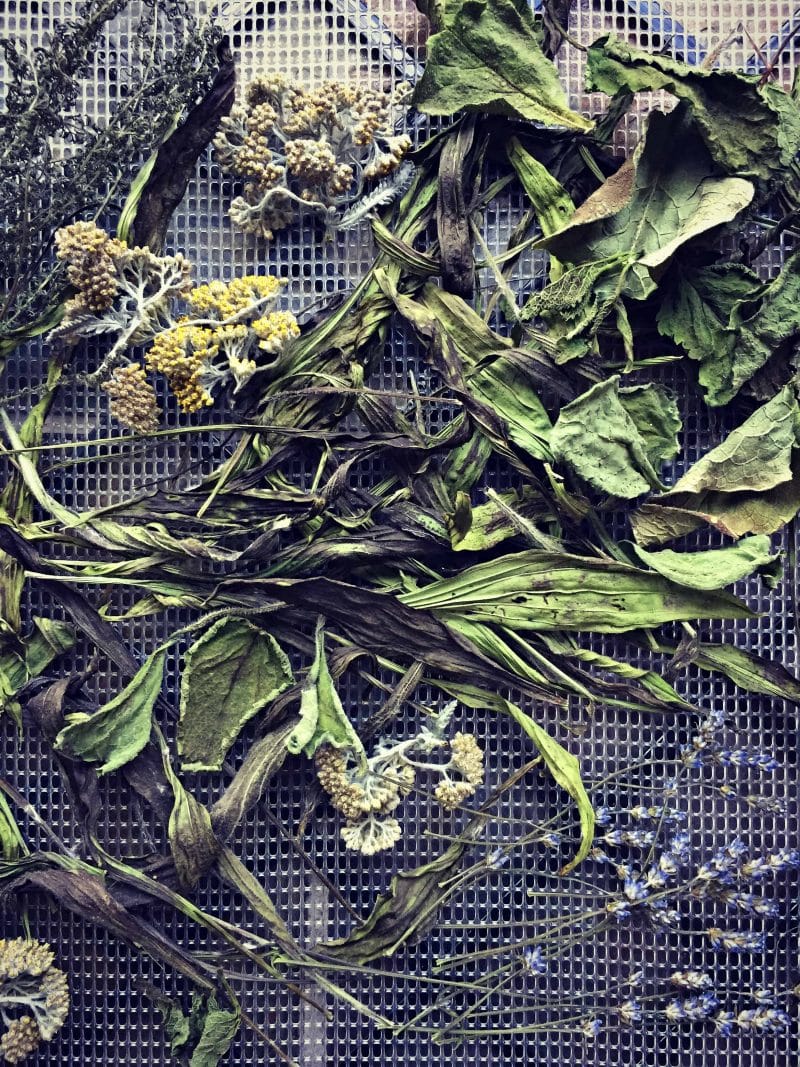
Make the Herb Infused Oil
Now it’s time to make your infused herbal oil. There are a few ways to do this; the first is to simply put your dried herbs in oil and let them sit in a cool place out of direct sunlight for several weeks.
I will often gently heat my oils as they’re infusing in my dehydrator a few times to help the process along.
You can use several different types of oil for your infusion, but olive oil is the most common. I also like to use coconut oil.
If you need your infused oil sooner, or if you want to use coconut oil, which is usually solid at room temperature, you can gently heat the herbs in the oil over a double boiler or in a slow cooker on low heat.
I was short on time and wanted to use some coconut oil, so I decided to go with this method. Plus, I recently acquired a slow cooker that came with a second mini slow cooker, and I discovered it’s is the perfect use for it!
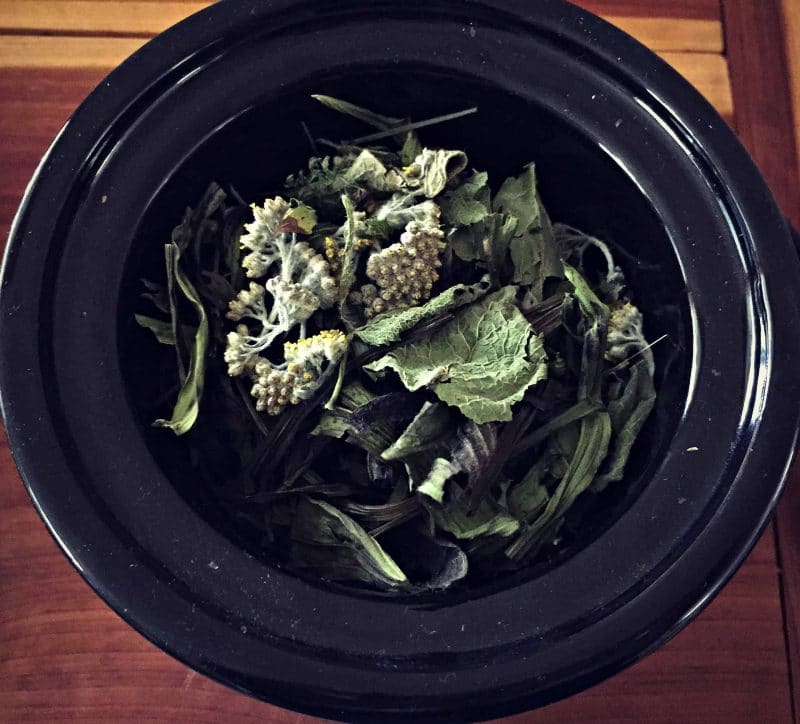
Crush up your dried herbs a bit and put them in your vessel, then cover with oil. I used a combination of olive and coconut oil, totaling approximately 1 ½ cups. The more oil you make, the more salve you can make.
Heat for several hours, making sure that it doesn’t get too hot and cook the herbs. I did this in the evening and turned off the heat before bed, letting the herbs continue to steep overnight.
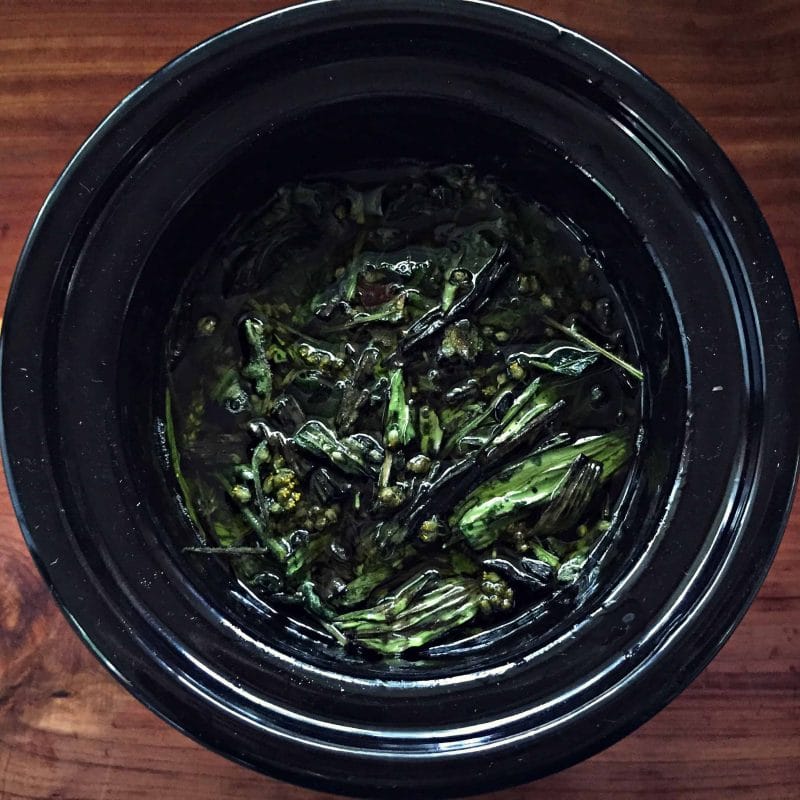
Make the Herbal Salve
The next morning, I had a very fragrant herbal oil infusion! Strain it through a sieve and cheesecloth into a bowl you can use as a double boiler.
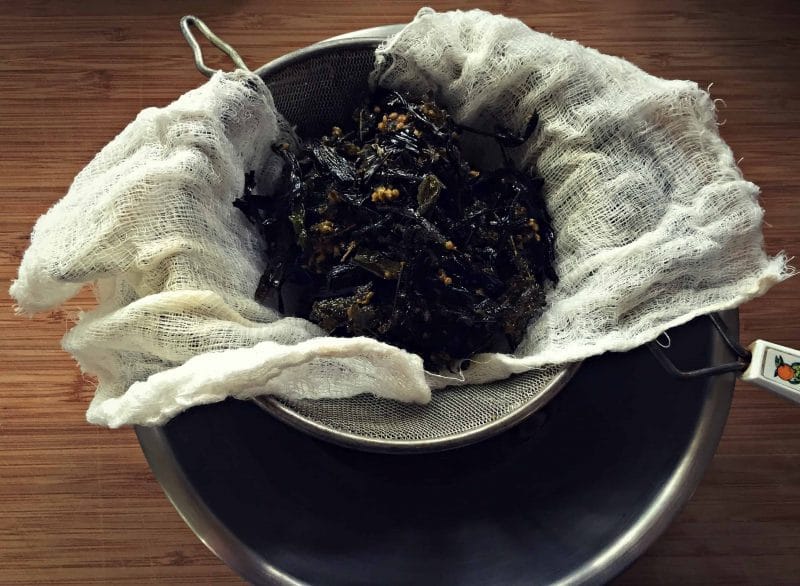
Use the cheesecloth and squeeze every last bit of oil into the bowl. Now that you have your herbal infusion, it’s time to gather the remaining necessary ingredients.
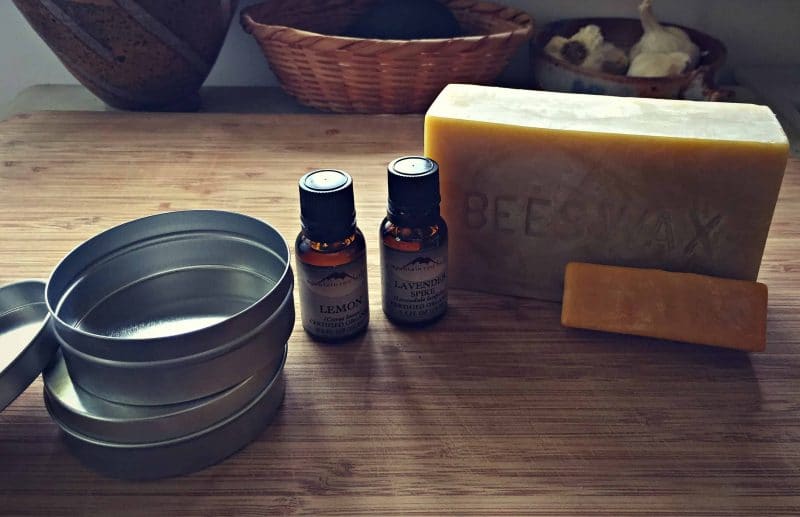
Beeswax (or carnauba wax for vegans), essential oils of your choice, and a vessel to store your finished salve (such as jars or tins) are all you’ll need, besides the infused oil.
I use about 1 ounce of beeswax (one small stick) per cup of infused oil, and lavender and lemon essential oils, to accentuate the lavender flowers and lemon balm in the salve.
Now everything comes together quite quickly. Put your bowl of herb infused oil onto a pot of boiling water, double boiler style. Cut your wax into chunks and add it to the warm oil.
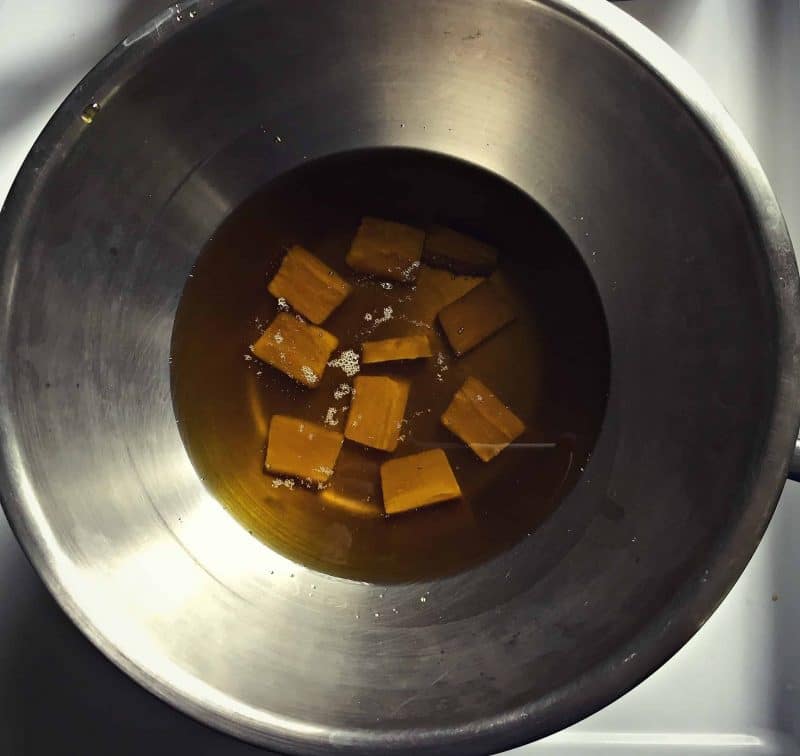
Once the oil heats up the wax should melt fairly quickly. When it’s completely melted, take the bowl off the heat (it’s probably hot!) and add drops of the essential oils. I did 12 drops of lavender and 6 drops of lemon.
Then carefully pour the salve mixture into the tins or jars.
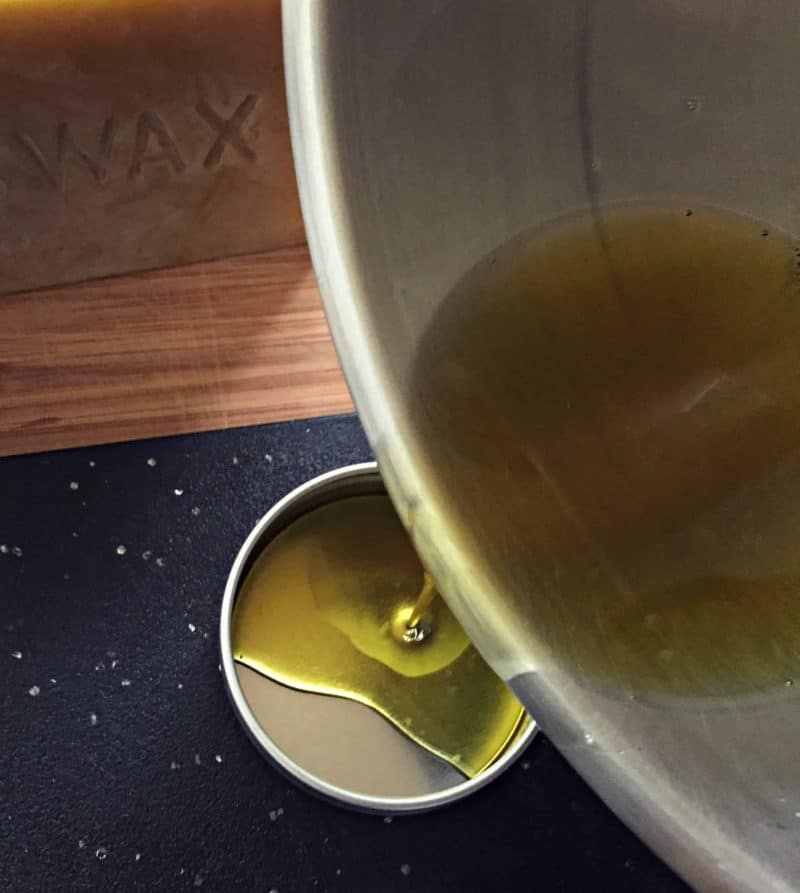
This batch that I made yielded two 4 ounce and two 2 ounce containers. I like to make various sizes so that I can stash them in different places such as my purse or the car.
Once the tins are full let them sit undisturbed for a few hours to solidify.
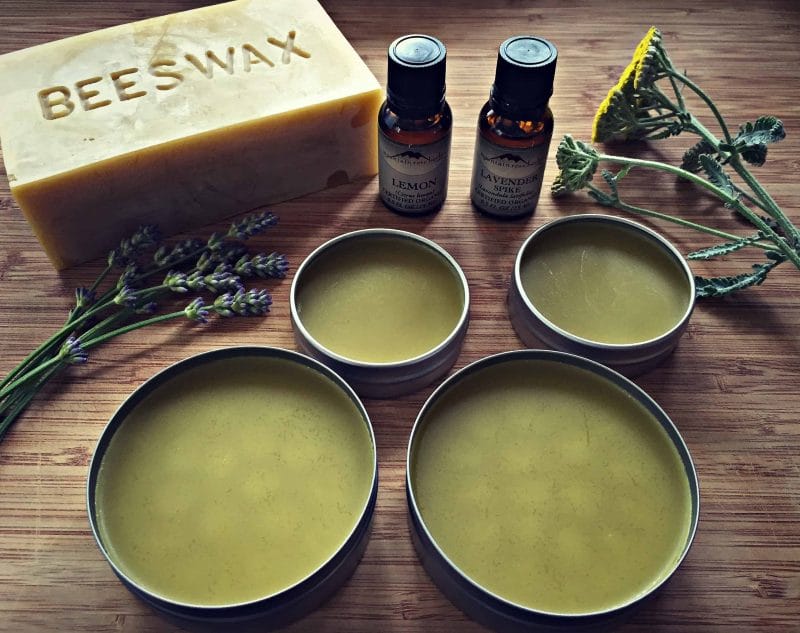
That’s all there is to it! It’s pretty amazing what we can make at home with just a few simple ingredients and a bit of time.
This herbal salve has the potential to help soothe minor cuts, scrapes, bruises, bites, stings, rashes, and dry skin. I use it on my hands and feet all the time.
Not only does it have astounding healing powers thanks to all the herbs it contains, but it smells absolutely divine!
You can also make this into a lip balm if you’d like, simply add more a bit more beeswax to help it hold up better on your lips.
Lip Balm Recipes
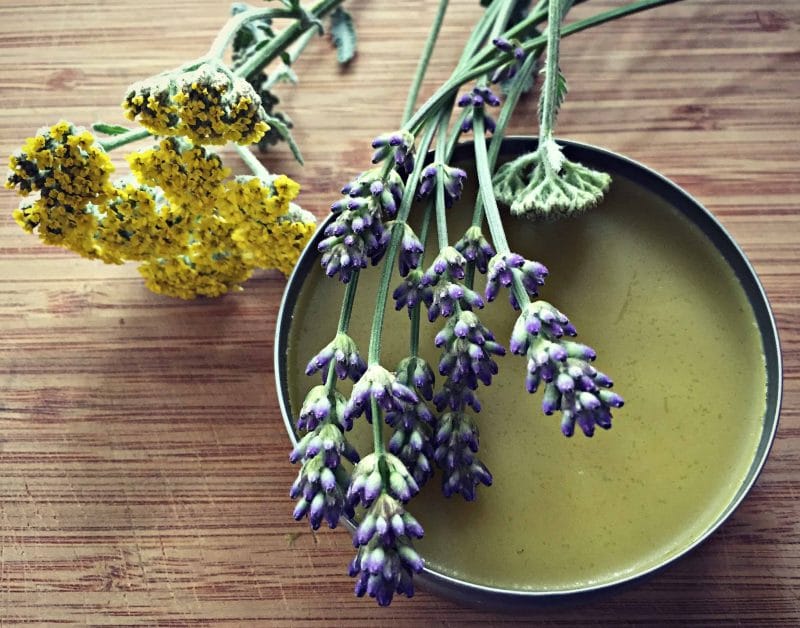
More Herbal Salve Recipes
- Dandelion Salve
- Yarrow Salve
- Plantain Salve
- Calendula Salve
- St. John’s wort Salve
- Bug Balm
- Comfrey Salve
- Manuka Honey Salve
- Diaper Rash Salve
- Pine Salve
Happy herbal salve making!
Herbal Salve
Ingredients
Herb Infused Oil
- 1 ½ cups carrier oil of choice olive, coconut, and/or sweet almond work well
- 1 cup dried herbs plantain, yarrow, comfrey, lavender, calendula, and/or lemon balm are all great options
Herbal Salve
- 1 cup herb infused oil
- 1 ounce beeswax
- 12-24 drops essential oils of your choice optional
Instructions
Herb Infused Oil (slow method)
- Put the dried herbs in a pint jar and cover with carrier oil.
- Cover and place in a cool spot out of direct sunlight for 4-6 weeks.
- Strain the herbs and reserve the oil for making salves.
Herbal Salve
- Heat the infused herbal oil in a double boiler. You can use a metal bowl or glass pyrex measuring cup over a pot of water if need be.
- Add the beeswax and stir until it completely dissolves.
- Remove from heat and stir in the essential oils.
- Carefully pour the mixture into jars or tins and set aside until the salve solidifies.
Notes
- Plantain leaves, comfrey leaves, yarrow leaves and flowers, lavender flowers, and lemon balm leaves would all make great choices for your herbal oil infusion.
- You can alternatively use the quick method for making infused oils by heating the oil and dried herbs in a pot on low heat for up to 12 hours, but the infused oil may not be as potent.
- I did 12 drops of lavender and 6 drops of lemon essential oils.
- Use the herbal salve on minor cuts, scrapes, bruises, bites, stings, rashes and dry skin.

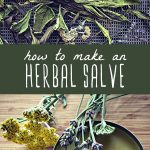
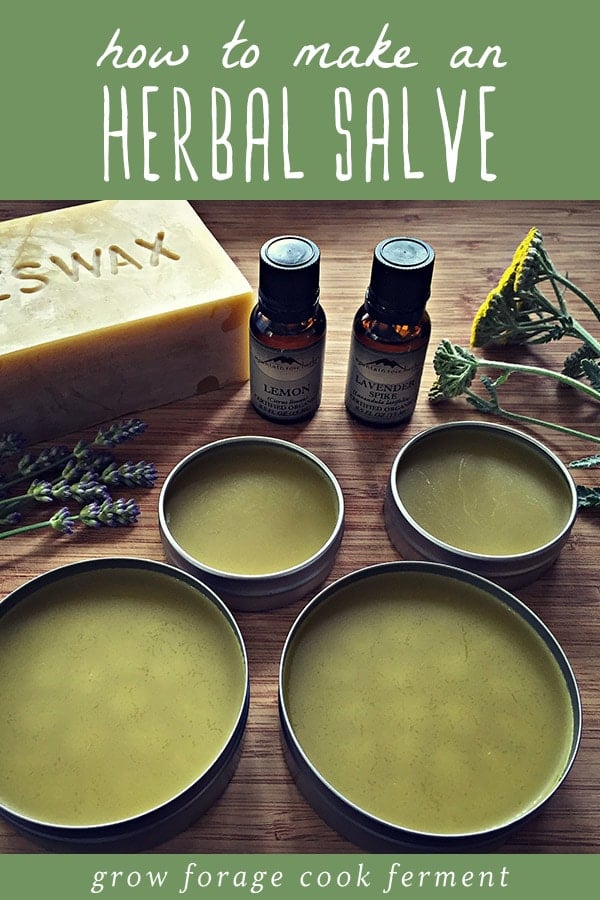
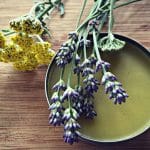

I just made my first batch of salve, but I think there must be some creative things to do with the herbs after you’ve extracted the oil? I feel wasteful just putting it into the compost!
Most, if not all, of the medicinal properties of the herbs should have been extracted into the oil, so I’m not sure what else you could use them for that would be any benefit.
Is there an easy way to clean up beeswax off of utensils or glasses?
I just use hot, soapy water.
Can you use CBD oil to make the infused oil?
You sure could!
Great article and photos. I wwas not aware that the yellow yarrow you depict is used for medicinal purposes? I have always used and known Achillea millefolium, which is typically white or pink for medicinal purposes.
It’s a question about yogurt… I love yogurt but it’s getting very expensive in the stores … Would you please do a video to make your own yogurt??? I would appreciate it immensely 🥰
Hi Tess. I actually have a yogurt recipe that you can check out here: https://www.growforagecookferment.com/how-to-make-yogurt-in-a-dehydrator/
Thank you so very much for your amazing site!! It has been popping up again and again as I begin to dip my toes into foraging to make an herbal salve with plants from the incredible land I’m on (Cape Breton Island, NS).
I’m looking to buy almond oil as a carrier oil, and what I’ve found online is a “skin care” almond oil that has vitamin E in it. Do you know if it would work to use that in the oil infusion? Or best pure almond oil?
Thank you very much!
I prefer pure 100% almond oil like this one: Sweet almond oil
Can we use Jajoba, grapeseed, avacado, or other organic oils ??? My daughter is allergic to anything coconut…
Yes, of course.
I am very happy to see and hear that people know how to work to make balms and creams the way they should. We got a great recipe (water based) and anyone who chooses to be consistent will have a good and fragrant balm. It must stand in the cold and must be consumed quickly. Thank you.
I am planning on making this salve and have a question approx. how much weight of herbs were used to make this batch?
Also can one add too many herbs?
Thank you so much your this information.
Yvonne
I used 12g herbs in this recipe. Because you’re straining the herbs out, there’s no danger in using too many herbs.
I love, love, love all of your sharings! Thank you so very much!
I am wondering how you clean out your bowl after the beeswax is melted and the liquid is in the containers? A little worried about the beeswax hardening and how to proceed with cleaning.
Thank you tons in advance. xo
I am surprised to see that you used dried plantain as I have heard several times that when it’s dried, plantain is basically useless compared to when it’s fresh! I once made a salve with dry plantain leaves and despite the other plants I added to it, it really was not that efficient…
I have bye me salve from a farmer market and they put salt in it it is for the lips balms how much salt to put in?
Hi there, what is the approximate shelf life of the salves? thanks so much for your gorgeous site.
This was great! Thank you for the instruction. I have just getting into herbal remedies and thought this would be a good place to start.
Are aluminum tins are safe for storing salves?
I’m not sure, that’s something that I will have to research further.
could I use coconut oil instead of bees wax?
No, it will not set up right without some kind of wax. You can use coconut oil as part of your infused oil, though!
Just a brief note regarding the temperature at which essential oils should be added.
We found that 50 C are optimum, at higher temperatures you will loose top notes.
Controlling the temperature throughout the process – with bees wax not above 70 C – will avoide overheating and getting an off odour from the wax.
Yarrow come in different colours, does it matter what colour it is.
I was taught that only the wild yarrow – Achillea millefolium- which is white or pinkish, has medicinal properties- it was called “woundwort” for years for its use on the battlefield to stop bleeding. I have seen this personally in action after a kitchen knife incident! Seriously amazing! The yellow yarrow, Eriophyllum confertiflorum is a different genus and species but may also have qualities that I don’t yet know about.
Can you use plantain too?
I’ve made wonderful herbal oils infused in the Mighty Fast Herbal Infuser. I’ve made infused oils for headaches, digestion and better sleep and they all have come out amazing. This machine infuses the oils and herbs perfectly. Then I use the oil and mix with beeswax or shea butter and perfection!
Kat ONID, I just got a Mighty Fast and would love to hear your recipes! I’m hoping to make some rubs for sore joints and muscles using *any* herbs/ingredients. Can you email to me? Thanks! micqueli at yahoo
Do you have a salve for cough and congestion